Mirror mirror on the wall, which is the fairest of them all? Yes, screen protectors are not just a piece of “transparent sticker”, and there are actually quite a number of different materials – Tempered glass, plastic, hydrogel, and more.
Does it really matter for something so thin? What is the difference, which one should you choose, and which is the best? I bought as many types of screen protectors that I can find, and did some not-scientific tests to find out – Read on!
TABLE OF CONTENTS
 Notes Notes |
 Screen Protectors Screen Protectors |
 Useful Bits & Links Useful Bits & Links |
 The End The End |
A FEW SMALL NOTES
 Before we go into the list of screen protectors, here are a couple of small notes on how “tests” are done on the screen protectors.
Before we go into the list of screen protectors, here are a couple of small notes on how “tests” are done on the screen protectors.
WHAT IS TESTED

Yes, no joke. I bought all the different types of screen protectors I can find on the Internet, and took hours to test them one by one:
- Fingerprints & Smears – Is the screen protector a fingerprint magnet?
- Optical Quality – Matte, glossy, or reflective? How good is the transmittance?
- Flexibility & Hardness – How much can it bend before breaking, is it scratch resistant?
- Application – How easy or difficult it is to install the screen protector.
But of course, trolls are welcome to scream “not tested scientifically”. The only testing tools I have are a pair of keys, a mini LED light, and a pair of hands.
HARDNESS LEVEL
The hardness level of a glass screen protector is commonly measured from 1H (softest) to 10H (hardest) using the Mohs scale. The general hardness of most glass protectors is about 5-7H, but shady sellers usually claim 8H and above. I don’t have the professional tools to verify that, but it is definitely around 6H if keys can scratch it.
P.S. If you see a 10H screen protector, that must be made out of diamond and cost a bomb. If not, a $2 piece of 10H screen protector is BS.
PHONE SCREEN PROTECTORS

All right, let us now get into the various types of screen protectors.
1) TEMPERED GLASS
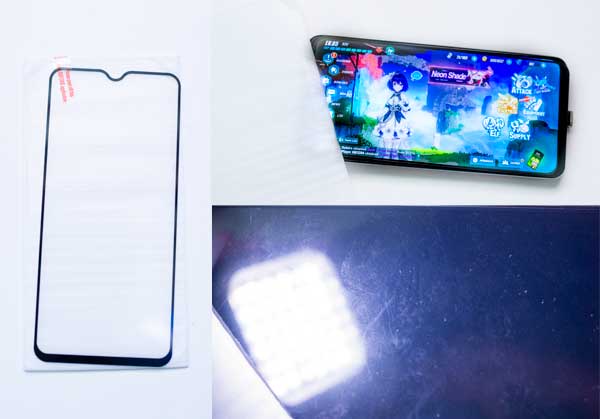
Optical Quality: Excellent clarity and transmittance, but highly reflective and glaring.
Flexibility & Hardness: Will survive scratches from keys, keychains, and the “normal pocket items”. Not flexible, shatters.
Application: Very easy. Clean the screen using a few drops of Zippo lighter fluid, then just slap the glass on. It pretty much “sticks” itself on.
Get From eBay: Click Here
You should be very familiar with this, tempered glass is one of the most common types of screen protectors on the market. Probably also one of the better choices, given the popularity. But take note that glass protectors usually consist of multiple layers – A silicon base layer, a PET film layer, and a glass layer on top.
While it does offer good scratch protection, all those layers make it thicker than the rest. You can forget an “invisible” screen protector with this one, this will definitely add a bit of extra thickness to the screen.
2) MATTE GLASS
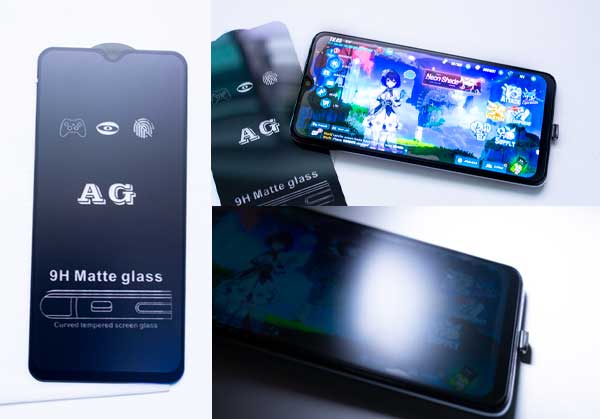
Optical Quality: Good transmittance, but the frosted surface takes some clarity away. Not reflective, no glare.
Flexibility & Hardness: It’s still glass. Not flexible, and shatters.
Application: Same as above, pretty easy with some “lighter fluid magic”.
Get From eBay: Click Here
This is the matte variant of the glass screen protector. It still offers the same good scratch resistance, but the surface has a “frosted quality” to it. This seems to reduce some clarity, but it also greatly reduces the amount of reflection and glare.
3) PRIVACY GLASS

Optical Quality: Good clarity, only if you look at it in front. Seems to darken the screen and doesn’t allow as much light to pass.
Flexibility & Hardness: It’s glass. Not flexible and shatters. But it has a guaranteed level of scratch resistance.
Application: Pretty easy with the lighter fluid trick.
Get From eBay: Click Here
Don’t like people looking at your screen while on buses and trains? Then consider getting one of these privacy screen protectors. They are essentially tempered glass screen protectors with a little bit of polarization magic, effectively restricting the viewable angles.
But this is not for everybody… You have to understand that it literally becomes a double-edged sword when you can’t see your own screen easily. Definitely not a good thing for gaming and watching videos. Use this only if you are some kind of superspy or do genuine sensitive work on your device.
4) POLYETHYLENE TEREPHTHALATE (PET) SCREEN PROTECTOR
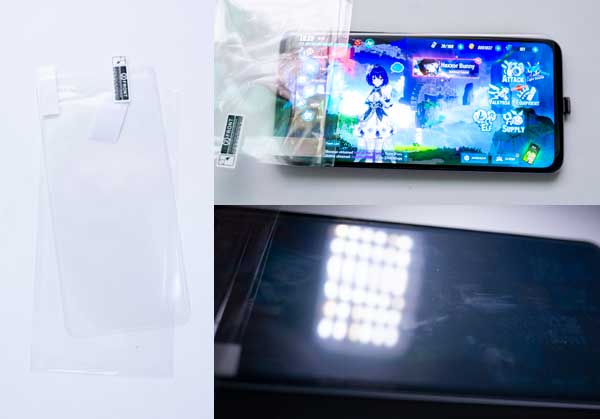
Optical Quality: Excellent clarity and transmittance.
Flexibility & Hardness: Fairly flexible, does not shatter. But I doubt this thin piece of plastic offers much scratch protection.
Application: Not so bad, just take some time to slowly apply and push the air bubbles out with a squeegee.
Get From eBay: Click Here
The funky scientific name aside, you may have already heard of PET bottles. Yep, this is essentially the same kind of plastic used to make recyclable bottles. PET screen protectors are rare these days, and as you can guess – They probably went extinct because they don’t offer much protection.
5) HYDROGEL
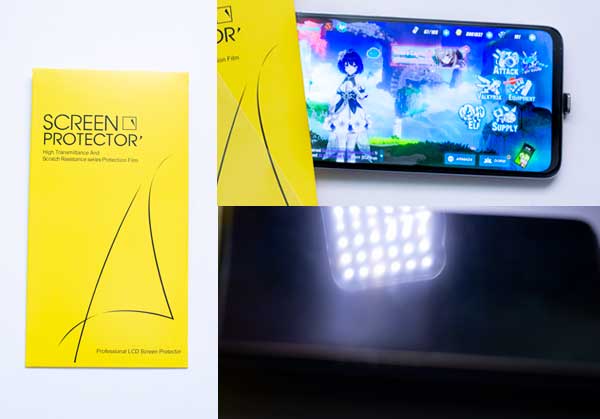
Optical Quality: Excellent clarity and transmittance, but very reflective.
Flexibility & Hardness: Rubbery texture, very flexible, will not shatter. Seemingly capable of handling minor scratches.
Application: The video tutorial goes “clean screen with provided fluid and stick it on in one smooth motion”. It took me a long time to “slowly stick and lift” if air bubbles are stuck. A squeegee doesn’t work well on the rubbery surface.
Get From eBay: Click Here
Yet another funky scientific name screen protector. In simple terms, the hydrogel is a “rubbery processed plastic”. It is not on the same level as PET, definitely better in some ways:
- Better scratch resistance than PET.
- Elastic, will not crack.
- Has some self-healing abilities, and can “fix” minor scratches by itself.
But there’s one thing I really hate about hydrogel. It is very difficult to apply, took me a long time to get rid of the air bubbles.
6) MATTE HYDROGEL
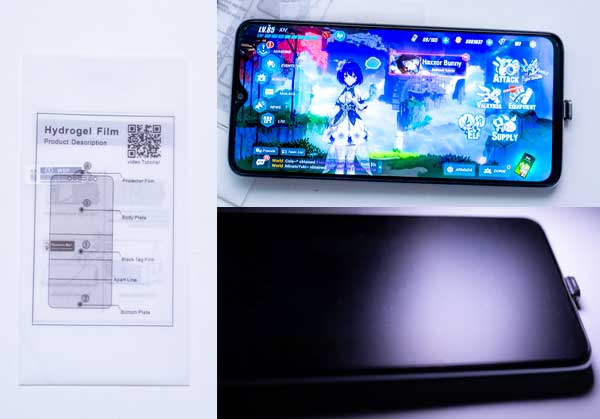
Optical Quality: Good clarity and transmittance, the matte surface does not reflect. No glare.
Flexibility & Hardness: Rubbery, does not shatter. Able to withstand a few minor scratches.
Application: Same as above, this is a pain to install.
Get From eBay: Click Here
The matte version of the hydrogel actually looks and feels good – If you hate fingerprints and don’t want to clean the screen every time, this is the right one for you. But just like the matte glass, the frosted surface seems to take away some clarity… A price that I will gladly pay to lessen the hassle of cleaning and reducing glare.
7) CERAMIC
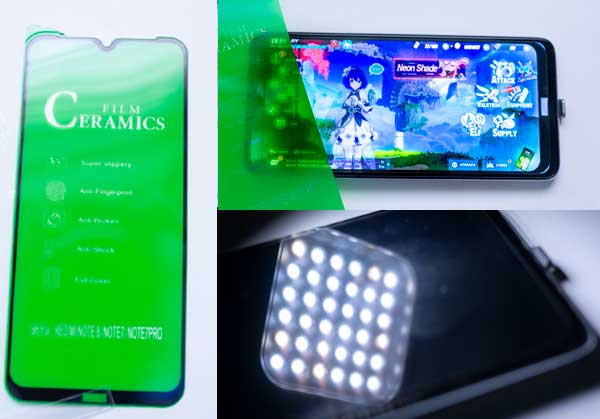
Optical Quality: Excellent clarity and transmittance, but it reflects and is glaring.
Flexibility & Hardness: Flexible, but will still crack if pushed to the limits. Seemingly as hard as glass, if not slightly better.
Application: Pretty easy, but the edges may need a little bit of “convincing”. Just leave some droplets of water on the edges of the screen, let the protector stick, and use a squeegee to push the air bubbles out.
Get From eBay: Click Here
Ceramics seem to be a cross in-between glass and plastic. It is flexible but not as flexible as plastic or gel… It will still shatter when put under too much stress. But the scratch resistance is something else – It seems to be even better than glass. Yep, the only thing I am not digging is the reflectiveness.
8) LIQUID GLASS SCREEN PROTECTORS
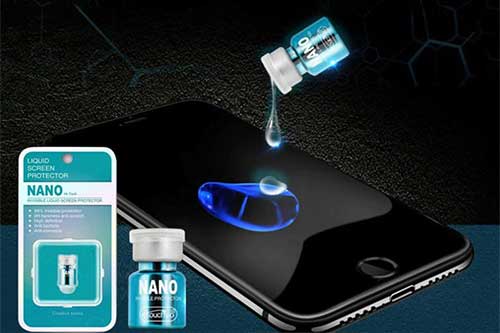
Lastly, there is this “nano miracle liquid self-healing glass” thing floating around the Internet… Just apply a thin layer, and the smartphone becomes indestructible like a Nokia. It will even repair itself. Well, all I can say is – What a load of BS. Don’t bother getting this.
USEFUL BITS & LINKS

That’s all for this guide, and here is a small section on some extras and links that may be useful to you.
WHICH IS THE BEST SCREEN PROTECTOR?
- Glass – Excellent optical quality. But they are reflective, shatter, and attract fingerprints.
- Ceramic – Seemingly, a better alternative for glass.
- Plastic – Good optical quality. Flexible and does not shatter. Although not as scratch-resistant as glass.
- Glossy – Have better transmittance, but attracts fingerprints and glares.
- Matte – Does not attract as many smears, not glaring, but at the cost of a little optical quality.
The point being, it’s all up to what you need.
- To prevent fingerprints on a smartphone, it is highly recommended to use a matte hydrogel screen protector.
- For better scratch resistance, use ceramic.
- For something that will not shatter, use plastic or gel.
LINKS & REFERENCES
- Understanding the Different Types of Phone Screen Protectors – fixmyphone
- What Kind of Screen Protector Should I Get for My Phone? – PCMagazine
- PET, TPU, or Tempered Glass – all you need to know to choose a screen protector – phonearena.com
- What Is Tempered Glass Screen Protector And Do You Really Need One?
THE END

Thank you for reading, and we have come to the end of this guide. I hope this has helped you to better understand, and if you have anything to share with this guide, please feel free to comment below. Good luck and may the cyber force be with you.

thnx man
it’s comprehensive.
Thank you
what is the type of nano anti broken screen?
It is type “BS and useless”.
Thank you so much, it’s really helpful ☺
Thank you for your information, this will help me make a better choice